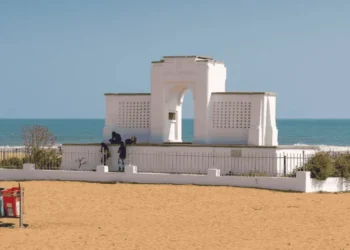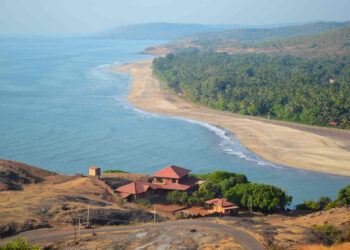In Ayodhya, Uttar Pradesh, by the Sarayu River, the Ram Janmabhoomi Temple stands where Lord Rama, the seventh avatar of Lord Vishnu, was born. This temple is dedicated to Lord Rama, a principal deity of Hinduism where devotees offer prayers and study the city’s old history. This blog tells the temple’s story, its legends, its build, its role in worship, and what you need to know to visit.
History of Ram Janmabhoomi Temple
The Ram Janmabhoomi Temple, as it is now, opened in January 2024 after years of argument over its land, known as Lord Rama’s birthplace. Old scriptures, like the Ramayana, say this very spot is divine. Some believe a temple stood here in the Gupta times, around the 4th to 6th centuries AD. Local tales tell of that old shrine being destroyed and rebuilt due to many Islamic attacks.
The temple site has long been at the center of communal tensions in India, as it stands on the grounds where the Babri Masjid once existed. Constructed between 1528 and 1529, the mosque became a point of dispute when idols of Rama and Sita were placed within its premises in 1949. The structure was later demolished in 1992 during a period of civil unrest. In 2019, the Supreme Court of India ruled that the land should be allocated to Hindus for the construction of a temple, while an alternative plot in Dhannipur, Ayodhya, was designated for the building of a mosque. The verdict cited findings by the Archaeological Survey of India, which indicated the remains of a non-Islamic structure beneath the former mosque.
The new temple was made by the Shri Ram Janmabhoomi Teerth Kshetra Trust after a 2019 court ruling allowed it. People across India, in fact, every Hindu household gave money to build it, showing Ayodhya’s place in Hindu’s heart. The site’s past, with its faith and struggles, makes it a sign of devotion and strength.
Legend of Ram Janmabhoomi Temple
The temple links to tales from the Ramayana and scriptures. The main story says this is where Lord Rama was born to King Dasharatha and Queen Kaushalya in the Treta Yuga, long ago. The Ramayana calls Ayodhya a great kingdom, with this spot made holy by Rama’s birth.
Architecture of Ram Janmabhoomi Temple
The temple follows the Nagara style, common in North India, with a high top. Built with pink sandstone and white marble, it has three floors. The main room holds an idol of Ram Lalla, the young Rama, in bright cloth and jewels. The black stone idol, calm and strong, is the heart of worship.
The temple covers 2.7 acres, with 392 pillars and 12 gates, carved with parts of the Ramayana. Smaller shrines for Hanuman and Sita sit in the big yard. No iron or steel was used, keeping to traditional building methods. A path around the main room lets devotees pray quietly.
Religious Significance
The Ram Janmabhoomi Temple is a main place for Hindus, honoring Lord Rama, seen as the best of goodness and duty. Devotees pray here for peace, strength, and a good life, moved by Rama’s story in the Ramayana. Daily aartis at 6:30 AM and 7:00 PM bring chants, bells, and incense, making a holy feel. Ram Navami, in March or April, marks Rama’s birth with songs, walks, and offerings like flowers and sweets.
Visiting Information for Ram Janmabhoomi Temple
How to Get There
The temple is in Ayodhya, reachable from big cities in Uttar Pradesh. Ways to get there are:
By Air: Ayodhya’s Maharishi Valmiki Airport, 10 kilometers away, is closest. Or, Lucknow’s airport, 135 kilometers away, joins big cities. Taxis or buses from either take 30 minutes or 2.5 hours to Ayodhya.
By Rail: Ayodhya Dham Junction, 2 kilometers away, links to Delhi, Lucknow, and Varanasi. Auto-rickshaws or taxis from the station take 10 minutes to the temple.
By Road: Ayodhya is 135 kilometers from Lucknow and 170 kilometers from Varanasi on NH 27. From Ayodhya’s center, auto-rickshaws or taxis take 5–10 minutes. Parking is near the temple.
Temple Hours
The temple opens daily, 6:00 AM to 9:00 PM. Aartis are at 6:30 AM and 7:00 PM, with longer hours for Ram Navami. Ask temple workers for festival times.
Best Time to Visit
October to March has cool weather, 10°C to 25°C, good for seeing Ayodhya. Ram Navami, in March or April, is full of life but busy. Summers, April to June, are hot, up to 40°C, so go early. Rainy months, July to September, can make paths wet, so step with care.
Rules for Visitors
Wear proper clothes: men need shirts and trousers or dhotis; women should wear sarees or churidar with a dupatta. No jeans or sleeveless tops.
Take off shoes before going in; a storage spot is there, with a small fee (₹2–5 per pair).
Photos are okay in the yard, but not in the main room; ask temple workers first.
Offerings like flowers or sweets are fine; talk to priests for special prayers.
No smoking, spitting, or alcohol. Eat prasad in the temple.
Bring water, sunscreen, and a hat for open areas. Watch for crowds at festivals.
Nearby Places
Hanuman Garhi: A Hanuman temple, 1 kilometer away, loved by those who pray.
Kanak Bhawan: A temple for Rama and Sita, 1.5 kilometers away, tied to their tale.
Sarayu River Ghat: A holy bathing spot, 2 kilometers away, linked to Rama’s life.
Nageshwarnath Temple: An old Shiva temple, 1 kilometer away, part of Ayodhya’s story.
Final Words
Ram Janmabhoomi Temple is undoubtedly one of the greatest achievement of Hindus in the last 100 years. With mentions in to the Ramayana, the temple lets visitors feel India’s authentic spiritual and cultural roots. A visit here brings you near Rama’s holy feet and the faith of his devotees making it a must visit in your travel list.











